Name Charles 2nd | Preceded by The Lord Northcote | |
 | ||
Monarch Queen VictoriaEdward VII Governor-General The Lord Curzon of KedlestonThe Earl of Minto Parents Alexander Baillie-Cochrane, 1st Baron Lamington Education | ||
Grandparents Thomas John Cochrane Great-grandparents Alexander Cochrane | ||
Charles Wallace Alexander Napier Cochrane-Baillie, 2nd Baron Lamington (29 July 1860 – 16 September 1940) was a British politician and colonial administrator who was Governor of Queensland from 1896 to 1901, and Governor of Bombay from 1903 to 1907.
Contents
- Early life
- Political career
- Governorships
- Later life
- Other Roles and Ranks Undated
- Personal life
- Legacy
- References
Early life
Born in London, England, he was the only son of Alexander Baillie-Cochrane, the 1st Baron Lamington. Charles was educated at Eton College and Christ Church, Oxford where he graduated with a Bachelor of Arts in 1883. In 1885, he became assistant private secretary to the Prime Minister of the United Kingdom, Lord Salisbury.
Political career
Cochrane-Baillie was narrowly defeated in the 1885 election for the borough constituency of St Pancras North, but he won the subsequent election in July 1886, taking his seat in the British House of Commons for the Conservative Party.
Upon the death of his father in 1890, he succeeded as the 2nd Baron Lamington.
On 13 June 1895, he married Mary Houghton Hozier at St Michael's Church, Pimlico; they had two children, a son and a daughter.
In 1890, the British Government sent Lord Lamington to travel between Tonkin in Vietnam and Siam, with a view to annexing at least the Xishuangbanna district and possibly the whole Yunnan province of China in an attempt to limit French colonisation of the area.
Governorships
In October 1895, Lord Lamington was selected to replace Sir Henry Norman as Governor of Queensland, and he was sworn in on 9 April 1896. He was a very politically conservative governor, and expressed a concern that the Federation of Australia which took place during his tenure would lead to unrestrained socialism. He also worked with the first Premier of Queensland, Sir Samuel Griffith, to ensure that the role of state governors was not diminished after Federation.
Apart from six months leave in England when he was knighted GCMG, Lord Lamington served as governor for five years until 19 December 1901. In 1903 he was made GCIE, and appointed as Governor of Bombay (until his resignation in Jul 1907 ), where the royal prerogative he exercised was far more powerful than it had been in Australia. He is also noted as being sympathetic, after having met ‘Abdu’l-Bahá, to the Bahá'í Faith.
Later life
Lord Lamington was appointed captain of the Lanarkshire Yeomanry on 26 March 1902.
In Spring 1919, he served as Commissioner of the British Relief Unit in Syria, prior to its allocation as a French mandate.
He returned to his family home, Lamington House, in Lanarkshire, Scotland, where he died on 16 September 1940, aged 80.
Other Roles and Ranks (Undated)
Personal life
Lord Lamington married Mary Houghton Hozier, the youngest daughter of William Hozier, 1st Baron Newlands, on 13 June 1895. They had two children, a son Victor Alexander Brisbane William Cochrane-Baillie (1896-1951, godson of Queen Victoria and in 1940 became the 3rd Baron Lamington) and a daughter Grisell Annabella Gem Cochrane-Baillie (1898-1985).
Legacy
Lord Lamington is best known in Australia for allegedly giving his name to the lamington, a popular Australian cake consisting of a cube of sponge cake dipped in chocolate icing and sprinkled with desiccated coconut. The stories of the creation of the lamington vary widely, although in most versions Lamington's chef Armand Gallan at Queensland's Government House devises the cake either by accident or due to a shortage of ingredients. Lamington is also reported to have referred to the cakes as "those bloody poofy woolly biscuits".
The Lamington Plateau and National Park in Queensland, Lamington Bridge in Maryborough, Queensland, Mount Lamington (a volcano in Papua New Guinea), and Lamington Road in Mumbai Lamington High School,Hubli were also named after him.
